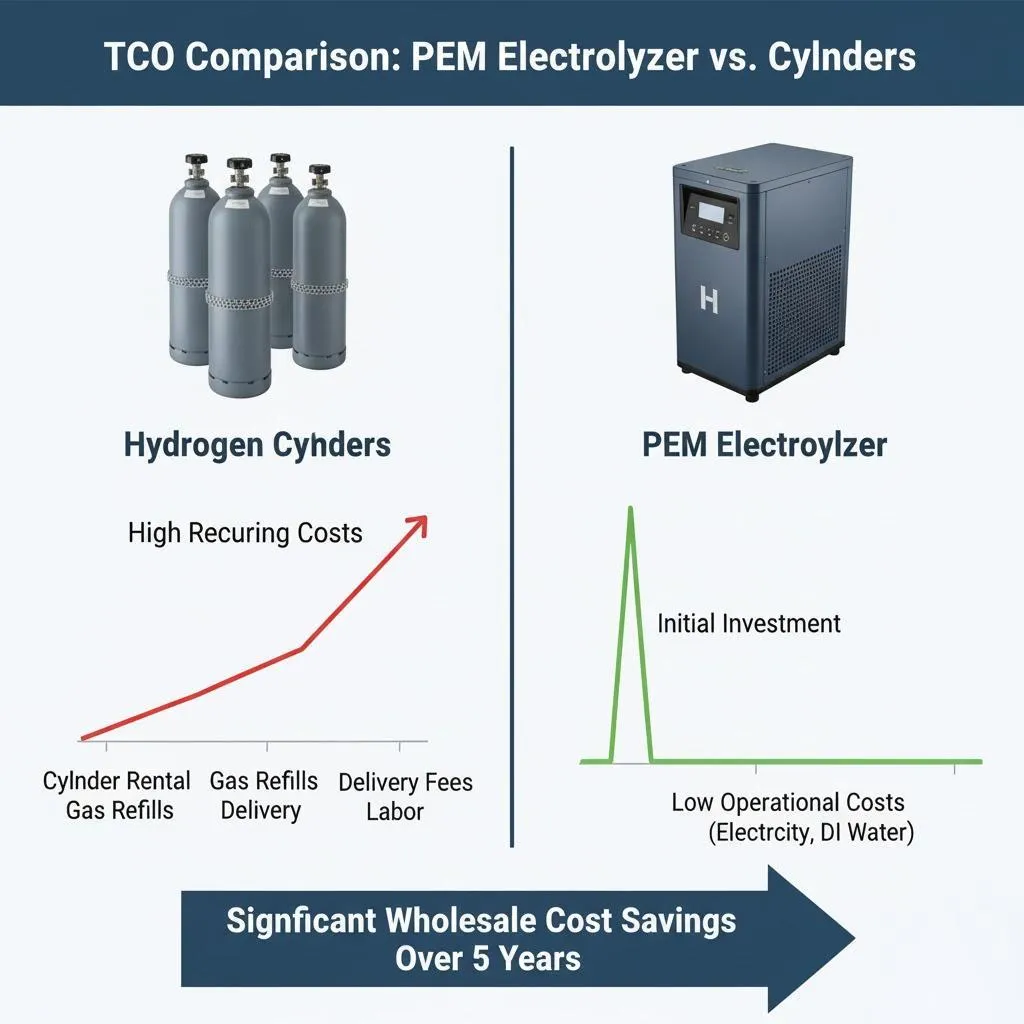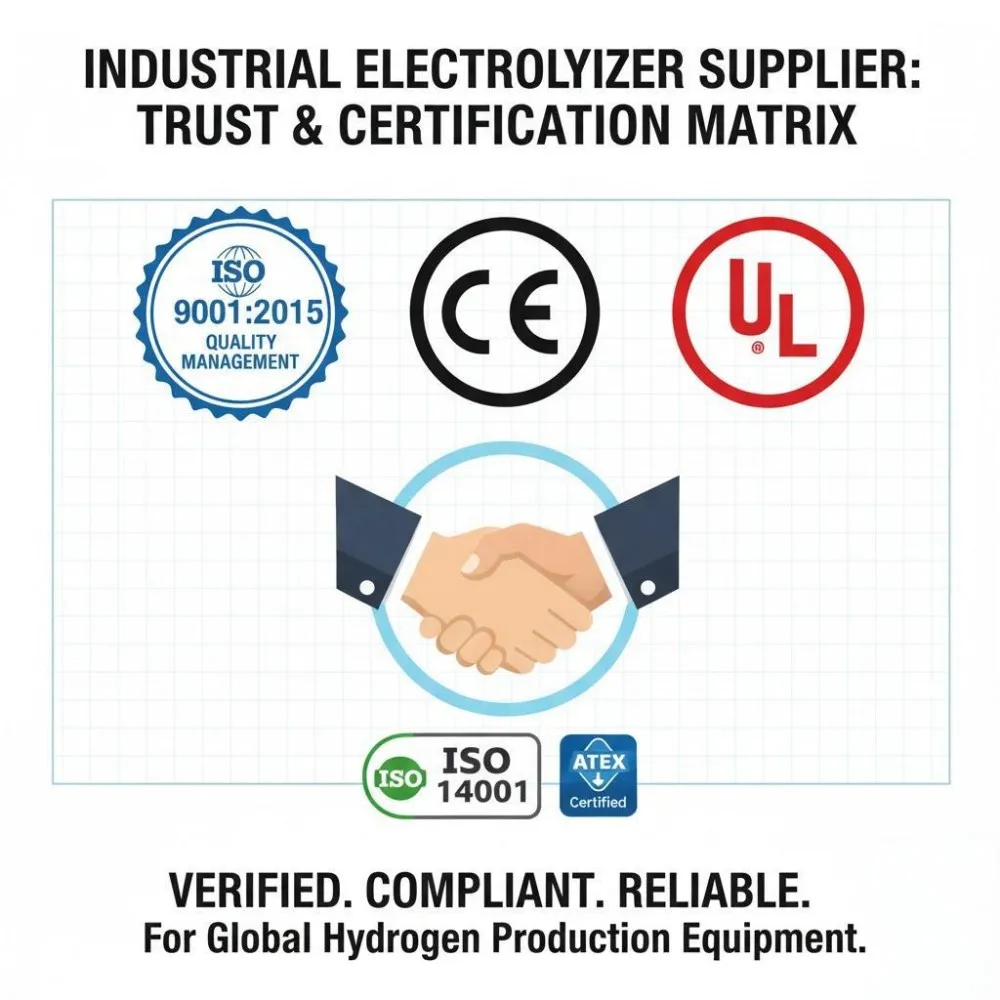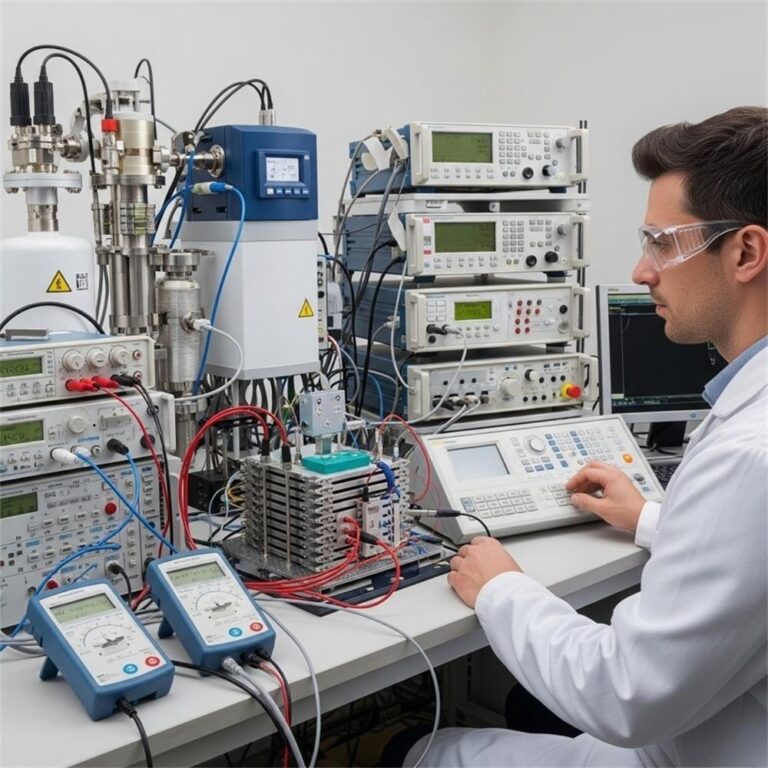1. Introduction to PEM Electrolysis Technology
Proton Exchange Membrane (PEM) electrolysis is a cutting-edge hydrogen production technology that uses electricity and water to generate ultra-pure hydrogen gas. Unlike traditional methods such as alkaline electrolysis, PEM systems employ a solid polymer electrolyte that facilitates the rapid transfer of protons while separating hydrogen and oxygen efficiently.
What makes PEM electrolysis truly stand out is its compact design, fast startup time, and exceptional gas purity—often exceeding 99.999%. These features make it an ideal solution for industries requiring a steady and high-quality hydrogen supply.
The 3000ml/min hydrogen powered PEM electrolyzer marks a pivotal advancement in small-to-mid scale industrial hydrogen production. Its output—equivalent to 3 liters per minute of high-purity hydrogen—bridges the gap between laboratory-scale units and massive centralized hydrogen plants. This makes it highly suitable for decentralized operations, clean energy integrations, and specialty industrial processes.
Compared to alkaline electrolysis, PEM systems:
- Operate at higher current densities
- Deliver faster response to load changes
- Occupy less space
- Eliminate the need for corrosive liquid electrolytes
As industries look for clean, modular, and efficient hydrogen solutions, 3000ml/min PEM electrolyzers offer the perfect balance between scale and sustainability.
2. Technical Specifications of 3000ml/min Hydrogen Powered PEM Electrolyzer
A typical 3000ml/min PEM electrolyzer is designed for high reliability and performance. Here’s a snapshot of its core specifications:
| Specification | Typical Value |
|---|---|
| Hydrogen Production Rate | 3000 ml/min (3 L/min or ~0.18 Nm³/h) |
| Power Consumption | ~500W – 1kW depending on efficiency |
| Hydrogen Purity | ≥99.999% (5N) |
| Working Pressure | Up to 30 bar (optional compressors) |
| Operating Temperature | 50–70°C |
| Dimensions (L×W×H) | Approx. 600×400×500 mm |
| Water Consumption | ~0.7 liters per hour |
These units are engineered for plug-and-play deployment with modular scalability. They’re ideal for integration into production lines, laboratories, or backup power systems. Their footprint is small enough for compact installations yet robust enough for continuous operation.
3. Key Components and How They Work
PEM Stack Construction
At the heart of the system lies the PEM stack—a series of electrolytic cells where water is split into hydrogen and oxygen. Each cell consists of:
- A proton-conductive membrane (e.g., Nafion™)
- Catalyst-coated electrodes (usually platinum or iridium)
- Bipolar plates for current distribution and fluid management
Water Purification System
Only ultra-pure, deionized water can be used. An integrated purification unit ensures consistent input quality, preventing membrane degradation and ensuring long-term operation.
Gas Separation Technology
The system precisely separates hydrogen from oxygen with no cross-contamination, thanks to gas diffusion layers and proper sealing mechanisms.
Cooling and Thermal Management
Electrolysis generates heat. Advanced systems use active air or liquid cooling to maintain optimal stack temperature, ensuring both efficiency and longevity.
Control Systems and Automation
Modern PEM electrolyzers include digital interfaces with:
- Real-time monitoring
- Automated diagnostics
- Remote control capabilities
- Safety interlocks
4. Industrial Applications and Use Cases
The 3000ml/min hydrogen powered PEM electrolyzer is an ideal fit for a wide range of industrial applications:
- Chemical Processing: Hydrogen is essential for processes like hydrogenation and methanol production.
- Semiconductor Manufacturing: High-purity hydrogen ensures defect-free wafer production during etching and deposition.
- Food Processing: Used for hydrogenation of oils and packaging atmospheres.
- Pharmaceutical Industry: Plays a role in API synthesis and sterile environments.
- Energy Storage: Can be integrated into power-to-gas systems for renewable energy storage.
- Research Labs: Delivers on-demand hydrogen without the need for gas cylinders.
Example: In semiconductor fabs, a 3000ml/min system can supply hydrogen for plasma-enhanced processes, supporting production with lower costs and improved process control.
5. Benefits for Industrial Users
Switching to a 3000ml/min PEM electrolyzer brings several advantages:
- ✅ Stable On-Site Supply: Eliminates the need for hydrogen delivery logistics.
- ⚡ High Energy Efficiency: Modern PEM systems can reach efficiencies over 70%.
- 🔧 Low Maintenance: Few moving parts mean fewer breakdowns and lower OPEX.
- ⏱️ Fast Startup: Ideal for intermittent operations or integration with solar/wind.
- 🌱 Eco-Friendly: Supports decarbonization with green hydrogen production.
- 💰 Cost Savings: Especially when compared with bottled hydrogen or trucked-in gas.
6. Cost Analysis and ROI Considerations
Here’s how the economics play out:
Initial Investment
- ~$5,000–$15,000 depending on build quality and optional integrations (e.g., pressure boost).
Operational Costs
- Mainly electricity and water
- Estimated at ~$0.50–$1.50 per Nm³ (based on local electricity prices)
Return on Investment
- ROI typically achieved in 2–4 years through savings on delivered hydrogen
- Accelerated if paired with renewable electricity
Additional Incentives
- Eligible for tax credits or subsidies in regions supporting hydrogen infrastructure
- Lower environmental compliance costs due to reduced carbon emissions
7. Safety Features and Compliance
Safety is paramount with hydrogen systems. These electrolyzers include:
- Leak Detection Sensors
- Overpressure Valves
- Emergency Stop Mechanisms
- Automatic Shutoff on Anomalies
- Compliance: Meets ISO 22734, CE, and other relevant safety standards
Proper installation and training are crucial to ensure safe and efficient operation.
8. Installation and Integration Guidelines
Setting up a 3000ml/min hydrogen powered PEM electrolyzer is straightforward:
Site Requirements
- Flat, ventilated space (preferably indoors)
- Access to power (typically 220–240V AC)
- Deionized water supply
Integration Tips
- Use pressure regulators if feeding sensitive equipment
- Include storage buffer tanks if needed
- Ensure proper ventilation to prevent hydrogen buildup
Pre-installation assessments can help avoid costly retrofits.
9. Maintenance and Service Requirements
Regular maintenance ensures long-term efficiency:
| Task | Frequency |
|---|---|
| Water filter replacement | Every 3–6 months |
| Membrane check | Annually |
| Sensor calibration | Quarterly |
| Full inspection/service | Every 12–18 months |
Support plans are available from most vendors, often including remote diagnostics and on-site assistance.
10. Future Developments in PEM Electrolyzer Technology
The future is bright for PEM electrolysis:
- 🔬 Material Innovations: New membranes and catalysts for better efficiency
- 📉 Cost Reductions: Mass production driving down component prices
- 🔗 Grid Integration: Smart systems will dynamically match power loads
- ⬆️ Scalability: Modular stacks can exceed 10x the current output
These trends point toward PEM becoming a cornerstone of clean hydrogen infrastructure globally.
11. How to Select the Right PEM Electrolyzer for Your Needs
Choosing the right system means asking the right questions:
- ✅ Is 3000ml/min enough for your application?
- ⚡ Does the system meet your energy constraints?
- 🔍 What certifications does it hold?
- 📈 Can it scale with your future needs?
Vendor Evaluation Tips:
- Request demo or pilot unit
- Check customer reviews and support availability
- Ensure post-sale maintenance is included
12. Conclusion and Next Steps
A 3000ml/min hydrogen powered PEM electrolyzer is an efficient, compact, and future-ready solution for industrial hydrogen needs. It offers a blend of performance, purity, and cost-effectiveness unmatched by traditional supply chains.
Next Steps:
- Assess your hydrogen demand
- Contact qualified vendors for quotes and consultations
- Explore government incentives in your region
For more details on hydrogen safety and integration, visit Fuel Cell & Hydrogen Energy Association.
FAQs
1. What is the typical lifespan of a 3000ml/min PEM electrolyzer?
Most systems last 5–10 years with proper maintenance, especially if operated under recommended conditions.
2. Can this system run on solar or wind energy?
Yes, PEM electrolyzers can work with variable renewable sources due to their rapid response time.
3. How pure is the hydrogen produced?
Typically ≥99.999% (5N), suitable for high-tech and chemical industries.
4. What maintenance does it require?
Routine tasks include replacing filters, checking membranes, and calibrating sensors.
5. Is it safe to operate indoors?
Yes, with proper ventilation, leak detection, and compliance with safety standards.
6. Can it be scaled for larger hydrogen demands?
Absolutely. Modular stack designs allow scaling to higher flow rates easily.







